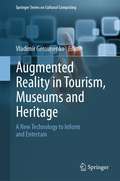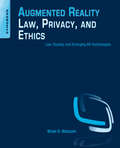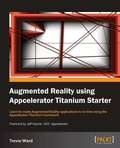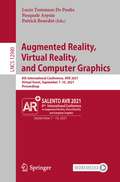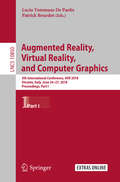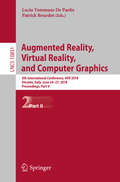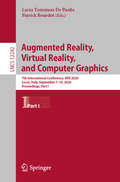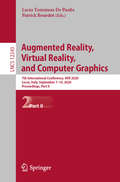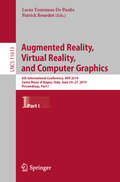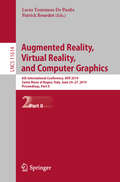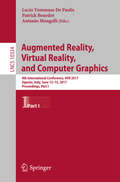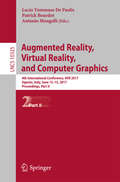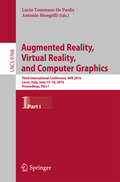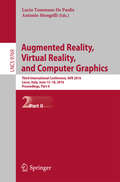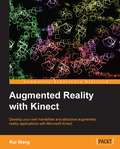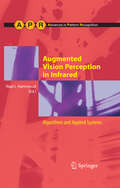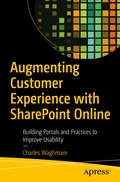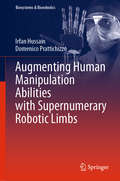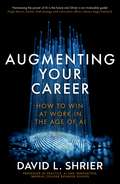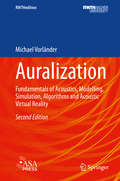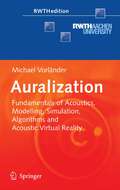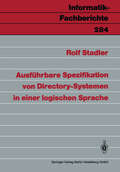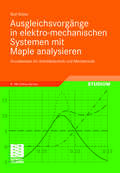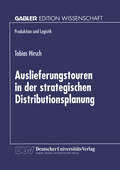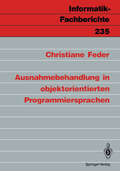- Table View
- List View
Augmented Reality in Tourism, Museums and Heritage: A New Technology to Inform and Entertain (Springer Series on Cultural Computing)
by Vladimir GeroimenkoThis book provides extensive research into the use of augmented reality in the three interconnected and overlapping fields of the tourism industry, museum exhibitions, and cultural heritage. It is written by a virtual team of 50 leading researchers and practitioners from 16 countries around the world. The authors explore the opportunities and challenges of augmented reality applications, their current status and future trends, informal learning and heritage preservation, mixed reality environments and immersive installations, cultural heritage education and tourism promotion, visitors with special needs, and emerging post-COVID-19 museums and heritage sites. Augmented Reality in Tourism, Museums and Heritage: A New Technology to Inform and Entertain is essential reading not only for researchers, application developers, educators, museum curators, tourism and cultural heritage promoters, but also for students (both graduates and undergraduates) and anyone who is interested in the efficient and practical use of augmented reality technology.
Augmented Reality Law, Privacy, and Ethics: Law, Society, and Emerging AR Technologies
by Brian WassomAugmented Reality (AR) is the blending of digital information in a real-world environment. A common example can be seen during any televised football game, in which information about the game is digitally overlaid on the field as the players move and position themselves. Another application is Google Glass, which enables users to see AR graphics and information about their location and surroundings on the lenses of their "digital eyewear", changing in real-time as they move about. Augmented Reality Law, Privacy, and Ethics is the first book to examine the social, legal, and ethical issues surrounding AR technology. Digital eyewear products have very recently thrust this rapidly-expanding field into the mainstream, but the technology is so much more than those devices. Industry analysts have dubbed AR the "eighth mass medium" of communications. Science fiction movies have shown us the promise of this technology for decades, and now our capabilities are finally catching up to that vision. Augmented Reality will influence society as fundamentally as the Internet itself has done, and such a powerful medium cannot help but radically affect the laws and norms that govern society. No author is as uniquely qualified to provide a big-picture forecast and guidebook for these developments as Brian Wassom. A practicing attorney, he has been writing on AR law since 2007 and has established himself as the world's foremost thought leader on the intersection of law, ethics, privacy, and AR. Augmented Reality professionals around the world follow his Augmented Legality® blog. This book collects and expands upon the best ideas expressed in that blog, and sets them in the context of a big-picture forecast of how AR is shaping all aspects of society.Augmented reality thought-leader Brian Wassom provides you with insight into how AR is changing our world socially, ethically, and legally.Includes current examples, case studies, and legal cases from the frontiers of AR technology.Learn how AR is changing our world in the areas of civil rights, privacy, litigation, courtroom procedure, addition, pornography, criminal activity, patent, copyright, and free speech.An invaluable reference guide to the impacts of this cutting-edge technology for anyone who is developing apps for it, using it, or affected by it in daily life.
Augmented Reality using Appcelerator Titanium Starter
by Trevor WardIt's a quick start tutorial to help you get started with creating Augmented Reality applications and acquainting yourself with essential aspects of creating AR applications using the Appcelerator Titanium Framework. The instructions are clear with easy to follow examples. This book is for anybody who wishes to understand how to build an Augmented Reality Application. It uses the Appcelerator Titanium mobile development framework, but the techniques and practices can be applied to other frameworks and native code. You will need to have a good working knowledge of development and JavaScript, it is not aimed at the beginner.
Augmented Reality, Virtual Reality, and Computer Graphics: 8th International Conference, AVR 2021, Virtual Event, September 7–10, 2021, Proceedings (Lecture Notes in Computer Science #12980)
by Lucio Tommaso De Paolis Pasquale Arpaia Patrick BourdotThis book constitutes the refereed proceedings of the 8th International Conference on Augmented Reality, Virtual Reality, and Computer Graphics, AVR 2021, held in Italy, in September 2021. Due to COVID-19 pandemic the conference was held virtually. The 38 full and 14 short papers were carefully reviewed and selected from 69 submissions. The papers discuss key issues, approaches, ideas, open problems, innovative applications and trends in virtual reality, augmented reality, mixed reality, applications in cultural heritage, in medicine, in education, and in industry.
Augmented Reality, Virtual Reality, and Computer Graphics: 5th International Conference, AVR 2018, Otranto, Italy, June 24–27, 2018, Proceedings, Part I (Lecture Notes in Computer Science #10850)
by Lucio Tommaso De Paolis Patrick BourdotThe 2-volume set LNCS 10850 and 10851 constitutes the refereed proceedings of the 5th International Conference on Augmented Reality, Virtual Reality, and Computer Graphics, AVR 2018, held in Otranto, Italy, in June 2018. The 67 full papers and 26 short papers presented were carefully reviewed and selected from numerous submissions. The papers are organized in the following topical sections: virtual reality; augmented and mixed reality; computer graphics; human-computer interaction; applications of VR/AR in medicine; and applications of VR/AR in cultural heritage; and applications of VR/AR in industry.
Augmented Reality, Virtual Reality, and Computer Graphics: 5th International Conference, AVR 2018, Otranto, Italy, June 24–27, 2018, Proceedings, Part II (Lecture Notes in Computer Science #10851)
by Lucio Tommaso De Paolis Patrick BourdotThe 2-volume set LNCS 10850 and 10851 constitutes the refereed proceedings of the 5th International Conference on Augmented Reality, Virtual Reality, and Computer Graphics, AVR 2018, held in Otranto, Italy, in June 2018. The 67 full papers and 26 short papers presented were carefully reviewed and selected from numerous submissions. The papers are organized in the following topical sections: virtual reality; augmented and mixed reality; computer graphics; human-computer interaction; applications of VR/AR in medicine; and applications of VR/AR in cultural heritage; and applications of VR/AR in industry.
Augmented Reality, Virtual Reality, and Computer Graphics: 7th International Conference, AVR 2020, Lecce, Italy, September 7–10, 2020, Proceedings, Part I (Lecture Notes in Computer Science #12242)
by Lucio Tommaso De Paolis Patrick BourdotThe 2-volume set LNCS 12242 and 12243 constitutes the refereed proceedings of the 7th International Conference on Augmented Reality, Virtual Reality, and Computer Graphics, AVR 2020, held in Lecce, Italy, in September 2020.* The 45 full papers and 14 short papers presented were carefully reviewed and selected from 99 submissions. The papers discuss key issues, approaches, ideas, open problems, innovative applications and trends in virtual reality, augmented reality, mixed reality, 3D reconstruction visualization, and applications in the areas of cultural heritage, medicine, education, and industry. * The conference was held virtually due to the COVID-19 pandemic.
Augmented Reality, Virtual Reality, and Computer Graphics: 7th International Conference, AVR 2020, Lecce, Italy, September 7–10, 2020, Proceedings, Part II (Lecture Notes in Computer Science #12243)
by Lucio Tommaso De Paolis Patrick BourdotThe 2-volume set LNCS 12242 and 12243 constitutes the refereed proceedings of the 7th International Conference on Augmented Reality, Virtual Reality, and Computer Graphics, AVR 2020, held in Lecce, Italy, in September 2020.*The 45 full papers and 14 short papers presented were carefully reviewed and selected from 99 submissions. The papers discuss key issues, approaches, ideas, open problems, innovative applications and trends in virtual reality, augmented reality, mixed reality, 3D reconstruction visualization, and applications in the areas of cultural heritage, medicine, education, and industry. * The conference was held virtually due to the COVID-19 pandemic.
Augmented Reality, Virtual Reality, and Computer Graphics: 6th International Conference, AVR 2019, Santa Maria al Bagno, Italy, June 24–27, 2019, Proceedings, Part I (Lecture Notes in Computer Science #11613)
by Lucio Tommaso De Paolis Patrick BourdotThe 2-volume set LNCS 11613 and 11614 constitutes the refereed proceedings of the 6th International Conference on Augmented Reality, Virtual Reality, and Computer Graphics, AVR 2019, held in Santa Maria al Bagno, Italy, in June 2019.The 32 full papers and 35 short papers presented were carefully reviewed and selected from numerous submissions. The papers discuss key issues, approaches, ideas, open problems, innovative applications and trends in virtual and augmented reality, 3D visualization and computer graphics in the areas of medicine, cultural heritage, arts, education, entertainment, military and industrial applications. They are organized in the following topical sections: virtual reality; medicine; augmented reality; cultural heritage; education; and industry.
Augmented Reality, Virtual Reality, and Computer Graphics: 6th International Conference, AVR 2019, Santa Maria al Bagno, Italy, June 24–27, 2019, Proceedings, Part II (Lecture Notes in Computer Science #11614)
by Lucio Tommaso De Paolis Patrick BourdotThe 2-volume set LNCS 11613 and 11614 constitutes the refereed proceedings of the 6th International Conference on Augmented Reality, Virtual Reality, and Computer Graphics, AVR 2019, held in Santa Maria al Bagno, Italy, in June 2019.The 32 full papers and 35 short papers presented were carefully reviewed and selected from numerous submissions. The papers discuss key issues, approaches, ideas, open problems, innovative applications and trends in virtual and augmented reality, 3D visualization and computer graphics in the areas of medicine, cultural heritage, arts, education, entertainment, military and industrial applications. They are organized in the following topical sections: virtual reality; medicine; augmented reality; cultural heritage; education; and industry.
Augmented Reality, Virtual Reality, and Computer Graphics: 4th International Conference, AVR 2017, Ugento, Italy, June 12-15, 2017, Proceedings, Part I (Lecture Notes in Computer Science #10324)
by Lucio Tommaso De Paolis Patrick Bourdot Antonio MongelliThe 2-volume set LNCS 10324 and 10325 constitutes the refereed proceedings of the 4th International Conference on Augmented Reality, Virtual Reality, and Computer Graphics, AVR 2017, held in Ugento, Italy, in June 2017. The 54 full papers and 24 short papers presented were carefully reviewed and selected from 112 submissions. The papers are organized in the following topical sections: virtual reality; augmented and mixed reality; computer graphics; human-computer interaction; applications of VR/AR in medicine; and applications of VR/AR in cultural heritage.
Augmented Reality, Virtual Reality, and Computer Graphics: 4th International Conference, AVR 2017, Ugento, Italy, June 12-15, 2017, Proceedings, Part II (Lecture Notes in Computer Science #10325)
by Lucio Tommaso De Paolis Patrick Bourdot Antonio MongelliThe 2-volume set LNCS 10324 and 10325 constitutes the refereed proceedings of the 4th International Conference on Augmented Reality, Virtual Reality, and Computer Graphics, AVR 2017, held in Ugento, Italy, in June 2017. The 54 full papers and 24 short papers presented were carefully reviewed and selected from 112 submissions. The papers are organized in the following topical sections: virtual reality; augmented and mixed reality; computer graphics; human-computer interaction; applications of VR/AR in medicine; and applications of VR/AR in cultural heritage.
Augmented Reality, Virtual Reality, and Computer Graphics: Third International Conference, AVR 2016, Lecce, Italy, June 15-18, 2016. Proceedings, Part I (Lecture Notes in Computer Science #9768)
by Lucio Tommaso De Paolis Antonio MongelliThe 2-volume set LNCS 9768 and 9769 constitutes the refereed proceedings of the Third International Conference on Augmented Reality, Virtual Reality and Computer Graphics, AVR 2016, held in Lecce, Italy, in June 2016.The 40 full papers and 29 short papers presented werde carefully reviewed and selected from 131 submissions. The SALENTO AVR 2016 conference intended to bring together researchers, scientists, and practitioners to discuss key issues, approaches, ideas, open problems, innovative applications and trends on virtual and augmented reality, 3D visualization and computer graphics in the areas of medicine, cultural heritage, arts, education, entertainment, industrial andmilitary sectors.
Augmented Reality, Virtual Reality, and Computer Graphics: Third International Conference, AVR 2016, Lecce, Italy, June 15-18, 2016. Proceedings, Part II (Lecture Notes in Computer Science #9769)
by Lucio Tommaso De Paolis Antonio MongelliThe 2-volume set LNCS 9768 and 9769 constitutes the refereed proceedings of the Third International Conference on Augmented Reality, Virtual Reality and Computer Graphics, AVR 2016, held in Lecce, Italy, in June 2016.The 40 full papers and 29 short papers presented werde carefully reviewed and selected from 131 submissions. The SALENTO AVR 2016 conference intended to bring together researchers, scientists, and practitioners to discuss key issues, approaches, ideas, open problems, innovative applications and trends on virtual and augmented reality, 3D visualization and computer graphics in the areas of medicine, cultural heritage, arts, education, entertainment, industrial andmilitary sectors.
Augmented Reality with Kinect
by Rui WangThis book is a mini tutorial with plenty of code examples and strategies to give you many options when building your own applications.This book is meant for readers who are familiar with C/C++ programming and want to write simple programs with Kinect. The standard template library can also be used as it is simple enough to understand.
Augmented Vision Perception in Infrared: Algorithms and Applied Systems (Advances in Computer Vision and Pattern Recognition)
by Riad I. HammoudThroughout much of machine vision’s early years the infrared imagery has suffered from return on investment despite its advantages over visual counterparts. Recently, the ?scal momentum has switched in favor of both manufacturers and practitioners of infrared technology as a result of today’s rising security and safety challenges and advances in thermographic sensors and their continuous drop in costs. This yielded a great impetus in achieving ever better performance in remote surveillance, object recognition, guidance, noncontact medical measurements, and more. The purpose of this book is to draw attention to recent successful efforts made on merging computer vision applications (nonmilitary only) and nonvisual imagery, as well as to ?ll in the need in the literature for an up-to-date convenient reference on machine vision and infrared technologies. Augmented Perception in Infrared provides a comprehensive review of recent deployment of infrared sensors in modern applications of computer vision, along with in-depth description of the world’s best machine vision algorithms and intel- gent analytics. Its topics encompass many disciplines of machine vision, including remote sensing, automatic target detection and recognition, background modeling and image segmentation, object tracking, face and facial expression recognition, - variant shape characterization, disparate sensors fusion, noncontact physiological measurements, night vision, and target classi?cation. Its application scope includes homeland security, public transportation, surveillance, medical, and military. Mo- over, this book emphasizes the merging of the aforementioned machine perception applications and nonvisual imaging in intensi?ed, near infrared, thermal infrared, laser, polarimetric, and hyperspectral bands.
Augmenting Customer Experience with SharePoint Online: Building Portals and Practices to Improve Usability
by Charles WaghmareBuild, enrich, and transform customer experience using SharePoint Online. This book will discuss different SharePoint Online approaches that you can use to enhance customer experience, including digital portals, enterprise content management, Microsoft Teams and much more. Augmenting Customer Experience with SharePoint Online starts with an introduction to SharePoint Online features you can adopt to create better digital customer experience and transformation. Next, you will learn about augmentation for user and customer experience followed by guidelines and methods to develop smart and intelligent portals. Moving forward, you will cover enterprise and web content management in detail along with the challenges and benefits of using SharePoint Online. The partner ecosystem is discussed next with a detailed discussion on working with suppliers, partners, and vendors. Along the way, you will see how to create smart solutions using SharePoint Online and how to manage customer references. Finally, you will go through the use of SharePoint Online in different business sectors with the help of case studies. After reading the book, you will be able to adopt SharePoint Online features to augment customer and user experience. What You Will Learn Augment customer experience Create smart and intelligent portals for various business needs Efficiently manage enterprise and web content Enhance your partner ecosystem for better collaboration Build SharePoint Online solutions Who This Book Is For Anyone wanting to adopt SharePoint Online to develop portals, content management systems, knowledge hubs, reference captures, or online foundries.
Augmenting Human Manipulation Abilities with Supernumerary Robotic Limbs (Biosystems & Biorobotics #26)
by Irfan Hussain Domenico PrattichizzoThis book offers a timely report on an emerging topic in the field of wearable assistive technology: the design and development of robotic extra fingers. After a concise review of the state of the art and a description of earlier prototypes, it discusses the authors’ efforts to address issues such as portability and wearability of the devices, including strategies to reduce fatigue and to integrate the motion of the extra fingers with that of the human hand. The book also explores optimized control algorithms and the design of wearable sensorimotor interfaces, and presents a set of tests carried out on healthy subjects and chronic stroke patients. Merging concepts from robotics, biomechanics, human factors and control theory and offering an overview of supernumerary robotic fingers, including the challenges, this book will inspire researchers involved in the development of wearable robotic devices and interfaces based on the principles of wearability, safety, ergonomics and user comfort.
Augmenting Your Career: How to Win at Work In the Age of AI
by David ShrierEssential reading for anyone who wants to be relevant in the workforce of tomorrow.Drawing on more than a decade of research on artificial intelligence and human systems, David L. Shrier, a globally recognised futurist and innovation specialist, delivers fascinating insights and tips on how to win at work in the age of AI. Artificial intelligence is driving workforce disruption on a scale not seen since the Industrial Revolution. Automation was once associated with mass layoffs in heavy industry like auto and steel, but computers are getting smarter and are beginning to replace traditionally 'white collar' roles like law, consulting, banking and finance.Yet some curious findings are emerging from the world's leading research labs. The combined intellect of people and machines working in harmony is able to achieve outcomes that are better than either can accomplish alone. Properly tuned AI systems can even help harness the power of the collective intelligence of an entire organisation or community to predict future events. This isn't science fiction; this is science fact the author personally helped discover.What are these new hybrid AI+people systems? What can specialised AI systems do to help you succeed in your career? How can you work most effectively with these machines?Written by a practitioner who has worked with some of the largest companies in the world as well as some of the most innovative startups, Augmenting Your Career provides a rare window into a frontier area of computer science that will change everything about how you work and what your job will look like. Read this book and fast track your evolution to the knowledge worker of the future.
Auralization: Fundamentals of Acoustics, Modelling, Simulation, Algorithms and Acoustic Virtual Reality (RWTHedition)
by Michael VorländerAuralization is the technique of creation and reproduction of sound on the basis of computer data. With this tool it is possible to predict the character of sound signals which are generated at the source and modified by reinforcement, propagation and transmission in systems such as rooms, buildings, vehicles or other technical devices. This book is organized as a comprehensive collection of the basics of sound and vibration, acoustic modelling, simulation, signal processing and audio reproduction. With some mathematical prerequisites, the readers will be able to follow the main strategy of auralization easily and work out their own implementations of auralization in various fields of application in architectural acoustics, acoustic engineering, sound design and virtual reality. For readers interested in basic research, the technique of auralization may be useful to create sound stimuli for specific investigations in linguistic, medical, neurological and psychological research, and in the field of human-machine interaction.
Auralization: Fundamentals of Acoustics, Modelling, Simulation, Algorithms and Acoustic Virtual Reality (RWTHedition)
by Michael VorländerThis is the first focused and detailed textbook on acoustic virtual reality. Auralization is the creation of audible acoustic sceneries from computer-generated data. The term "auralization" is to be understood as being analogue to the well-known technique of "visualization". In visual illustration of scenes, data or any other meaningful information, in movie animation and in computer graphics, we describe the process of "making visible" as visualization. In acoustics, auralization is taking place when acoustic effects, primary sound signals or means of sound reinforcement or sound transmission, are processed to be presented by using electro-acoustic equipment. This book is organized as a comprehensive collection of basics, methodology and strategies of acoustic simulation and auralization.
Ausführbare Spezifikation von Directory-Systemen in einer logischen Sprache (Informatik-Fachberichte #284)
by Rolf StadlerDas Buch behandelt die Spezifikation von Directory-Systemen unter Anwendung von Konzepten der logischen Programmierung. Ausgehend von der Definition derArchitektur eines Directory-Systems wird eine Spezifikationsmethode zur Beschreibung solcher Architekturen vorgestellt. Als Spezifikationssprache dient die Sprache der Hornklausel-Logik, erweitert um Negation. Im Buch werden eine von D.B. Terry bei Xerox PARC entworfene Architektur und ein Ausschnitt aus der Architektur des internationalen Standards f}r Directory-Systeme (X.500) spezifiziert. Daran lassen sich die Vorteile der vorgeschlagenen Methode aufzeigen: Die Spezifikationen sind kompakt, gut lesbar und besitzen eine deklarative und eine prozedurale Semantik. Die erstellten Spezifikationen lassen sich auf einem Prolog-System ausf}hren. Die Ausf}hrbarkeit der Spezifikationen erweist sich als vielseitig anwendbare Eigenschaft, welche beispielsweise die Simulation eines Directory-Systems bei gegebener Konfiguration erm|glicht oder die ]berpr}fung (Verifikation, Validierung) einer Spezifikation erleichtert.
Ausgleichsvorgänge in elektro-mechanischen Systemen mit Maple analysieren: Grundwissen für Antriebstechnik und Mechatronik
by Rolf MüllerDas Buch vermittelt Grundlagen der Modellierung, Analyse und Simulation elektromechanischer Systeme unter Verwendung des Computeralgebra-Systems Maple. Am Anfang werden die für die Arbeit mit Maple notwendigen Befehle in konzentrierter Form anhand von einfachen Beispielen vorgestellt. Ausführlich wird danach auf das Lösen von Differentialgleichungen und Differentialgleichungssystemen mit Maple eingegangen. Das Vorgehen bei der Ermittlung analytischer und numerischer Lösungen wird beschrieben und an zahlreichen Beispielen erläutert.
Auslieferungstouren in der strategischen Distributionsplanung (Produktion und Logistik)
by Tobias HirschTobias Hirsch entwickelt ein heuristisches Verfahren, das die Auswirkungen von Standortentscheidungen auf die Tourenkosten bei täglich wechselnder Auftragssituation abschätzt. Die Leistungsfähigkeit des Verfahrens wird an Praxisbeispielen verdeutlicht.
Ausnahmebehandlung in objektorientierten Programmiersprachen (Informatik-Fachberichte #235)
by Christiane FederDie Ausnahmebehandlung ist ein vor allem bei der Automatisierung technischer Prozeßsysteme eingesetztes Sprachmittel. Trotz vieler Entwurfs- und Implementierungsvorschläge für Ausnahmemechanismen blieben die formalen Aspekte der Ausnahmebehandlung bisher weitgehend unberücksichtigt. In diesem Buch wird eine neue Theorie der Ausnahmebehandlung vorgestellt. Für die formale Beschreibung setzt die Autorin die denotationelle Methode der Semantikdefinition ein. Damit kann insbesondere die Einflußnahme der Ausnahmebehandlung auf die Ablaufsteuerung eines Programms, also die wichtigste Auswirkung von Ausnahmemechanismen, sehr elegant, präzise und übersichtlich dargestellt werden. Das Buch wendet sich an Leser, die sich über die Möglichkeiten der Ausnahmebehandlung informieren, Programmiersprachen um einen konkreten Ausnahmemechanismus erweitern oder bestehende Mechanismen vergleichen wollen. Das Ausnahmekonzept wird verständlich und nachvollziehbar dargestellt, ohne daß auf die notwendigen Formalismen verzichtet werden muß. Dabei werden auch die zum Verständnis nötigen Konzepte und Begriffe der objektorientierten Programmierung und der denotationellen Semantikbeschreibung eingeführt.
